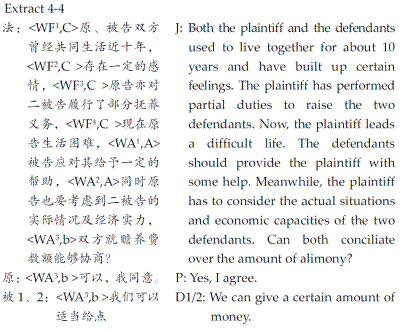DIA provides a systematic way to analyze discourse information used in courtroom. For example, in court conciliation discourse, through the analysis of discourse information used, we can find out how judges in court persuade parties to change their attitudes. Next is an example from the book “Realization of Persuasion in Chinese Court Conciliation: The Discourse Information Approach” to illustrate how factual discourse information is used to help parties have a clearer picture of the case.
Apart from providing an objective basis for the determination of the liability in a combination with WJ information, factual discourse information may also enable parties to get a better understanding of the case. It describes what has happened in the case and guides them to reflect upon the past events and look for a better solution to their disputes.
In the following extract, the plaintiff, who used to be the two defendants’ step-father and raised them for nine years when they were still underage, has economic difficulties in daily life and wants the defendants to support him. To persuade both parties to conciliate, factual discourse information is used to describe what has happened to them in the past. The three legal facts (WF1, WF3 and WF4) validate the obligation of supporting stepfather by the defendants through logical appeal, while the inferred fact (WF2) resorts to emotional appeals and provides a common ground for both parties to conciliate. The common ground “provides a platform on which to negotiate other agreements and generates an air of optimism, mutuality and confidence” (Boulle, 2005, p. 197). Based on the platform provided by the factual discourse information, the judge shows the common ground and makes the rendering of the court’s attitude more acceptable. Thus, the combination of WF and WA help make the attitude concerning mutual understanding more objective and persuasive.

To be more specific, factual discourse information is presented through the logical appeal, establishing connections between the abstract requirements of the governing article and the actual situation of this case. According to Article 27 of the Marriage Law of the People’s Republic of China, “The relevant provisions in this Law governing the relationship between parents and children shall apply to the rights and duties in the relationship between stepfathers or stepmothers and their stepchildren who receive care and education from them.” This article prescribes that as long as stepparents raise and educate stepchildren, stepchildren have the obligation to support them when they are unable to work or have difficulties in life.
In this extract, three WF information units are presented to state the current situation and provide reasons for the application of Article27. The first one (WF1) is an indisputable legal fact which proves the relationship of stepfather and stepchildren between both parties. The second one (WF3) is a legal fact proved by evidence through the court proceedings, proving the existence of care and education. The third one (WF4) is a legal fact which points out the difficulties the step father as at present. Based on these three legal facts, the current situation of the case is made clear which lists all the constituent elements in Article 27. It paves the way for the coming attitude (WA1) of the court that the defendants should support the plaintiff. Except for the above three legal facts, it is also worthwhile to notice that the second fact (WF2), though not been proved by evidence, can be still inferred from the first legal fact (WF1) that both parties have lived together for almost ten years. It emphasizes feelings between both parties, implying a need for mutual understanding. It sets a ground for the judge’s coming subjective attitude (WA2) that the plaintiff has to consider the reality and economic capabilities of the defendants, and make it easier to be accepted.
